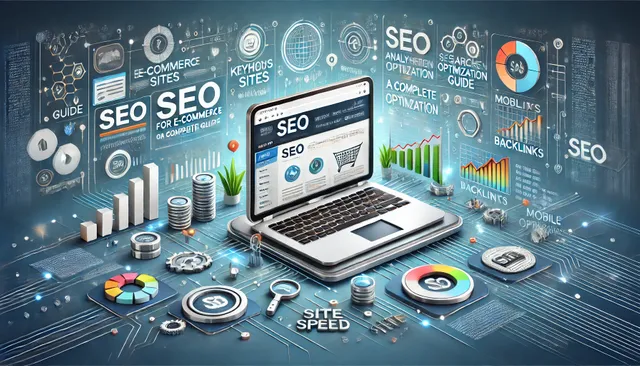SEO for E-commerce Sites: A Complete Optimization Guide
SEO for E-commerce Sites: A Complete Optimization Guide
You’ve got an e-commerce store. You’re putting in the work—great products, decent traffic, maybe even some sales. But you’re not hitting the numbers you want. Why? Because your SEO game isn’t strong enough.
Google’s algorithm changes. Competitors outrank you. Your product pages vanish in search results. It’s frustrating. But here’s the truth: SEO isn’t magic. It’s a system. And if you follow this guide, you’ll rank higher, get more traffic, and make more sales.
Let’s break it down—no fluff, just straight-up strategies that work.
Why E-Commerce SEO Matters
If your site isn’t optimized, you’re leaving money on the table. Period.
-
93% of online experiences begin with a search engine (Google, mostly).
-
70% of clicks go to the first five organic results. If you’re not there, you’re invisible.
-
E-commerce sites with strong SEO see 2-3x more conversions than those without.
You need SEO. Not tomorrow. Now.
Step 1: Keyword Research (The Right Way)
You can’t rank if you’re targeting the wrong keywords. Here’s how to fix that:
Find Buyer-Intent Keywords
-
Use tools like:
-
Focus on:
-
Commercial keywords (“buy running shoes online”)
-
Long-tail keywords (“best wireless headphones for gym 2024”)
-
LSI keywords (semantically related terms like “durable,” “affordable,” “reviews”)
-
Check Competitor Keywords
-
Plug competitor URLs into Ahrefs or Ubersuggest.
-
Steal their best-performing keywords (ethically).
Step 2: On-Page SEO (Optimize Every Product Page)
Google needs to understand your pages. Here’s how to make that happen:
Title Tags & Meta Descriptions
-
Keep titles under 60 chars.
-
Include primary keyword first.
-
Meta descriptions under 160 chars—make them click-worthy.
Example: ❌ "Shoes – Buy Now" ✅ "Best Running Shoes for Men (2024) – Lightweight & Durable | YourBrand"
URL Structure
-
Short, clean, keyword-rich.
-
❌ *yoursite.com/product123*
-
✅ yoursite.com/mens-running-shoes
Product Descriptions That Sell
-
No copied manufacturer descriptions.
-
Write unique, benefit-driven copy.
-
Use bullet points for readability:
-
✔ Lightweight design for speed
-
✔ Breathable mesh keeps feet cool
-
✔ 30-day money-back guarantee
-
Image Optimization
-
Compress images (use TinyPNG).
-
Use descriptive file names (not “IMG_1234.jpg”).
-
Add alt text with keywords (“blue-mens-running-shoes”).
Step 3: Technical SEO (Fix the Backend Stuff)
If your site is slow or broken, Google won’t rank it.
Site Speed
-
Aim for <2s load time (check with PageSpeed Insights).
-
Optimize images, enable caching, use a CDN.
Mobile-First Indexing
-
Google ranks mobile-friendly sites higher.
-
Test with Mobile-Friendly Test.
Fix Broken Links
-
Use Screaming Frog to find 404 errors.
Schema Markup
-
Helps Google understand your products.
-
Use Product Schema for prices, reviews, and availability.
Step 4: Content Marketing (Blogs & Guides)
Product pages alone won’t cut it. You need top-of-funnel content to attract buyers.
Blog Post Ideas for E-Commerce SEO:
-
“10 Best Running Shoes for Marathon Training”
-
“How to Choose the Right Headphones for Your Workout”
-
“Wireless vs. Wired Earbuds – Which is Better?”
Pro Tip: Link to your product pages within blog posts.
Step 5: Link Building (Get Authority Backlinks)
More high-quality backlinks = higher rankings.
Ways to Get Backlinks:
-
Guest posts on industry blogs.
-
HARO (Help a Reporter Out) – Get featured in news articles.
-
Broken link building – Find dead links, suggest your content.
-
Promote your content on platforms like:
-
Mediageneous (Great for social media & YouTube promotion)
-
Step 6: User Experience (UX) & Conversions
SEO brings traffic. UX turns visitors into buyers.
Improve UX With:
-
Clear CTAs (“Add to Cart” buttons above the fold).
-
Customer reviews (social proof increases trust).
-
Easy navigation (categories, filters, search bar).
FAQs (Quick Answers to Common Questions)
Q: How long does e-commerce SEO take to work?
A: 3-6 months for solid results. SEO is a long game.
Q: Should I use exact-match keywords?
A: No. Google prefers natural language. Use synonyms and variations.
Q: How often should I update my product pages?
A: Refresh descriptions, images, and prices every 6-12 months.
Q: Is paid ads better than SEO?
A: Ads get fast traffic, SEO gets free, long-term traffic. Use both.
Final Thoughts
SEO isn’t optional for e-commerce. It’s the way to get free, targeted traffic that converts.
Recap: ✔ Target buyer-intent keywords ✔ Optimize every product page ✔ Fix technical issues ✔ Publish helpful content ✔ Build high-quality backlinks ✔ Improve UX for higher conversions
Start today. Track results. Adjust. Repeat.
And if you need help promoting your e-commerce brand, check out Mediageneous for boosting your social media and YouTube growth.
Now go rank. 🚀
